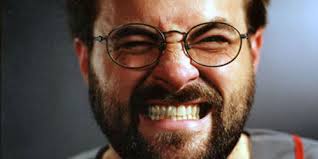After our first cinema "lecture" I frolicked out of the classroom buzzing head to toe with the desire to make another film. It had been too long since CP1, and I just gotten done sitting in a circle of folk similar to myself listening to a man remind us that our wildest movie-making dreams can come true (as long as we aren't chumps about it and work our tails off.) I don't know about you guys, but I'm ready to work my tail off. Which got me to thinking of fellow film-makers who rolled out of bed and did what they loved, even when every other element of the universe was pulling them towards not doing so. One in particular came into mind today, Kevin Smith.

Few filmmakers tug at my heartstrings with their display of tenacity like this man does. One could riddle me biased, seeing as my heart tends to always go out to fellow passionate, creative and working class minimum wagers such as myself. Sometimes people make it seem easy - making films. Some come from families with deeper pockets and have significantly more resources at their fingertips. They attain an education and equipment with ease much like the flick of a wand. Smith had nothing but a pocketful of inspiration fueled by Richard Linklater and his film
Slacker taking off from Sundance. (Smith was hoping the same would come of him and his film
Clerks - spoiler alert... it did.) Learning more about how this screenwriter, actor, film producer, speaker and director got his foot in the door was a refreshing bout of knowledge to ingest. In my opinion, he is the epitome of "all it takes to make films is the drive to make films."
So, how does a broke, inexperienced twenty four year old behind a convenient store counter manage to hash out a film that wins the highest award at Sundance Film Festival? With nothing more but a few screenplays locked away, Smith emerged from seemingly nowhere with his movie that was later picked up by Miramax! How?!
By doing whatever he had to.
He'd work his shift at the shop, and after closing up, it was immediately transformed into the set for his movie. For twenty one straight nights this director, producer as well as actor of this film clocked in at 6am, clocked out at 11pm and then shot until the wee hours of the morning and wrapped around 4am. (If any, Kevin would manage two hours sleep while shooting Clerks.) Nearly $30,000 was charged to various credit cards Kevin had fenangled throughout the years, adding up to the entire films budget. His shoestring allowance was displayed on black and white film due to various lighting types and shot on one location. His cast consisted of friends and even his mother to try and reduce cost of production. Since his boss would exclusively let Smith film off of business hours, explanation towards closed shutters were sprinkled into the plot. In the opening scene, the locked security gates are surpassed by the protagonist (Dante) hanging a sign that reads I ASSURE YOU, WE'RE OPEN due to them being "jammed by gum." Smith admitted himself the film appeared to be a total disaster when it was first showcased on a screen.
The film was anything but as it made over $3 million at the box office. This obviously funneled funds for future film making into Smith's pocket. His goal was made, for the man said it himself, "We wanted to make Clerks as a showcase to say 'obviously we can make movies, can we get money to make more please?'"
Jay and Silent Bob, the dynamic duo (played by Jason Mewes and Kevin Smith himself) that are featured in many of Kevin's films, didn't make their true splash in the audience until Clerks hit home video. Smith knew however, that Mewes made the character that was "Jay" long before. Unfortunately, the executives at Universal were against him filling the role for any future films and were set on finding a replacement. Smith put his foot down, maintained his creative backbone and eventually swayed the company into allowing the duo to stick together into Kevin's next film Mallrats, under a few conditions that is:
- The studio refused to fly Mewes out to Minnesota for rehearsal or shooting unlike the rest of the cast and crew
- He would be denied a hotel room on location
- He would not be payed for the months worth of rehearsal, everyone else would
- If after the first day, Mewes was deemed "unworthy," he would be canned and replaced with Seth Green.

Both Smith and Mewes assumed this was how actors and directors were treated in the big leagues. So Smith payed for his friend's plane ticket out of his own pocket, headed off to Minnesota, shared a hotel room with him and shot their second movie.
Soon after, Smith's decision to cast Mewes was rewarded by an article in Rolling Stone entitled "5 Minute Oscars" in which the author listed the best performances in movies that year by people with the least amount of screen time. Jay's character was mentioned and praised in great detail within the article, which transformed Universals hateful gazes towards Mewes into eyes chock full of dollar signs. The company took off to merchandizing the character.
I feel it's obvious why Kevin Smith is one of the film makers that gives me hope, but if the adversity he overcame isn't enough, his mindset towards doing what he loves holds enough inspiration in itself. He mentions in an interview that through those twenty-two hour long days during Clerks he kept on telling himself "of course this will work" and said that if he had stopped to think of the possibility of no one liking his movie at Sundance that it "woulda killed it and I'd still be working at Quick Stop thinking "huh I wonder if I could've made a movie.'"








